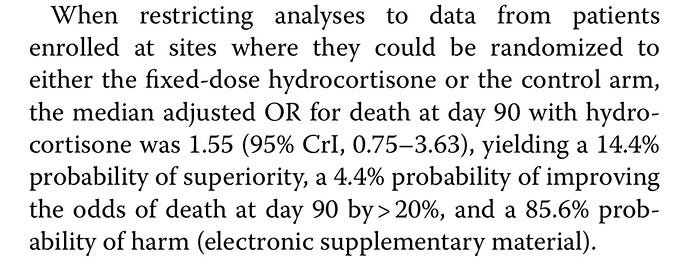REMAP-CAP delivered a science-mimic
I don't know about you, but I am tired of Prof Annane's corticosteroid studies.
I don't know about you, but I am tired of Prof. Annane's corticosteroid studies. Twenty-five years, professor! I have been on the reading side of such studies since the late 90s. Sadly, He's been on a fruitless quest for decades, insisting on corticosteroids without ever checking his premises. Notwithstanding, he is behind a perpetual sepsis study built on failed premises.
REMAP-CAP is also a perpetual platform study with the noble mission of studying one of humanity's foes, community-acquired pneumonia (CAP). They randomize patients for treatments like statins (I swear I thought CAP was an infectious disease) and corticosteroids, all the RCTs at the same time. Patients get entangled within the groups, but smart guys on their R suites disentangle the patients and control for everything in regression analyses. If results suck, they go Bayesian. The plan is to drop new papers in a perpetual stream.
The recent REMAP-CAP steroid paper features another perpetual member of the Task Force Class, Dr. Angus, whose failed method will likely be taught forever. But this time, the report is so confusing that it didn't appear in JAMA.

The story of corticosteroids in severe community-acquired pneumonia and everything else in critical care is a story of decades of bad science, starting when Petty and Bone invented ARDS and sepsis, respectively. The REMAP-CAP corticosteroids trial encapsulates everything wrong in critical care.
Of course, the paper is deeply embedded in Dogtensivism. It is theory-free science, to begin with, as they never bothered to develop a disease model in which corticosteroids would dominantly treat CAP patients already receiving antibiotics and ventilatory support. The study has other Dogtensivism features I encourage you to explore, like Blindness to Marginal Utility and Augmented Data Analysis. But today I am not chasing Dogtensivists. I just read a newsletter-worthy Datamethods post from Dr. Lawrence Lynn.
Dr. Lynn and I have been discussing the weaknesses of the Petty and Bone RCT for a while. We have a book on how it damaged critical care medicine, and how you and I are products of Petty and Bone's decades-old mistake. Please find the book here. I also have several posts on the topic. Enough preliminaries. Here's Lynn's post.
Just published was one of the most shocking divergent results in acute care medicine, the REMAP-CAP “RCT”, testing of hydrocortisone for severe community acquired pneumonia. The results included a 14.4% probability of benefit and an 85.6% probability of harm.
This despite most of the previous trials including CAPE COD found benefit, including a meta analysis. Worse, the standard protocol based on the previous RCT calls for giving corticosteroids so this is a stunning rebuttal of prior RCT by the highly touted REMAP CAP. You will notice an interesting spin when you read the discussion because this result is profoundly shocking to those who actually thought REMAP CAP was a valid RCT.
Most in the field are shocked and the ripple is felt in social media. However those who have read this thread could have predicted this result as REMAP CAP is a PettyBone RCT which is not really an RCT but rather an “RCT mimic”. (A wide range of different diseases are lumped together under the criteria including a range of viral and bacterial pneumonia)
REMAP CAP is the most ambitious PettyBone RCT platform in history. COViD was separated out in one study so it has spun out a real RCT.
Nevertheless there is no getting around that REMAP-CAP is an RCT mimic. Bradford Hill did not allow the lumping of many different diseases tested together with a single intervention in a single RCT, he taught the opposite so this is an “RCT mimic”. It looks like an RCT but it does not have the pivotal features of an RCT.
(The problem here is not DoE, because this is not a real RCT in the first instance.)
So what could have been done to render a real RCT. The answer is to perform individual RCT on each disease separately. Sure they could be in the same platform but you can’t lump them for an RCT. Sure that’s more difficult but it can be done with large multicenter trials.
In contrast this PettyBone disease lumping shortcut renders an RCT mimic which, although it is easier, actually renders a falsely high true n for each disease in the mix.
This marks another failed PettyBone RCT in a 30 plus year history of failed PettyBone RCT with many protocols reverted due to harm. The public deserves action to eliminate RCT mimics by defining a standard setting the features which must be present to qualify as a real RCT.
When the RCT was invented in the 1940s, it was meant to test a treatment for a unique and well-specified disease. Moreover, the RCT should be the final test of a theoretical conjecture, a disease model presenting a dominant cause of death or morbidity.
Only when a conjecture is carefully elaborated can its consequences be tested in an RCT. Take the seminal Bradford Hill tuberculosis randomized clinical trial. They spent years developing the hypothesis that anti-tuberculosis drugs were effective against the mycobacterium. This was built upon the discovery that TB was caused by Koch's bacillus.
The disease model was straightforward, and, of course, only patients with active TB were included. Obviousnesses must be reiterated in 2025! Accordingly, REMAP-CAP conducted great research on Covid because it is one disease.
However, giving corticosteroids to anyone with CAP and ventilatory or cardiovascular failure is a different game. When you lump different causes, the results are never reproduced because the case mix is not reproducible. Then the field swims in circles, as we have been doing for decades within the corticosteroids “domain”.
Unfortunately, the Task Force Class doesn't see the lack of reproducibility as a refutation of the Petty and Bone lumping strategy. They see it as an opportunity for a meta-analysis. Wait and see.
I side with Dr. Lynn. It's time to stop bad science. Hello NIH!
Thank you for reading The Thoughtful Intensivist!
Our points here might be a novelty for many of you, especially my most recent readers. I invite you to check the following free posts:
If you want a deeper dive on epistemology, plausibility, and pre-clinical research translation, please visit:









The continued publication of these sorts of studies leaves me baffled and a little anxious. I am left wondering how much of what I think I know about anesthesiology comes from studies such as these. It has changed the way I read medical literature and question outcomes. And, yes, I do think twice about these studies.
I believe Dylan nailed it again:
Well, it ain't no use to sit and wonder why, babe
If'n you don't know by now
And it ain't no use to sit and wonder why, babe
It'll never do somehow